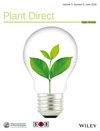缺水胁迫下 GTL1 的转录抑制促进了花青素的生物合成,从而增强了耐旱性
IF 2.3
3区 生物学
Q2 PLANT SCIENCES
引用次数: 0
摘要
转录因子 GT2-LIKE 1(GTL1)与协调多种生理、生化和发育过程的转录网络有关。在限水条件下,GTL1 是气孔发育的负调控因子,但它在其他缺水反应中的潜在作用尚不清楚。我们假设 GTL1 在叶片发育阶段调控与耐旱性相关的转录组变化。为了验证这一假设,我们在水分充足和缺水的条件下,通过 RNA-seq 分析了野生型和耐旱的 gtl1-4 基因敲除突变体新叶和展开叶的基因表达谱。我们对叶片发育年龄内的基因型-处理组合进行了比较分析,分别在新叶和展开叶中发现了 459 个和 1073 个差异表达基因,这些基因是对缺水有响应的 GTL1 调控基因。转录剖析确定了 GTL1 在以前与耐旱性相关的两个重要途径中的潜在作用:类黄酮和多胺的生物合成。在膨大的叶片中,缺水条件下 GTL1 的负调控促进了类黄酮和花青素的生物合成,这可能有助于提高耐旱性。多胺的定量分析并不支持 GTL1 在这些干旱响应途径中的作用,但这可能是由于多胺合成和周转的复杂性。我们的全球转录组分析表明,缺水对 GTL1 的转录抑制允许植物激活多种途径,这些途径共同促进了植物的耐旱性。本文章由计算机程序翻译,如有差异,请以英文原文为准。
Transcriptional repression of GTL1 under water‐deficit stress promotes anthocyanin biosynthesis to enhance drought tolerance
The transcription factor GT2‐LIKE 1 (GTL1) has been implicated in orchestrating a transcriptional network of diverse physiological, biochemical, and developmental processes. In response to water‐limiting conditions, GTL1 is a negative regulator of stomatal development, but its potential rolein other water‐deficit responses is unknown. We hypothesized that GTL1 regulates transcriptome changes associated with drought tolerance over leaf developmental stages. To test the hypothesis, gene expression was profiled by RNA‐seq analysis in emerging and expanding leaves of wild‐type and a drought‐tolerant gtl1‐4 knockout mutant under well‐watered and water‐deficit conditions. Our comparative analysis of genotype‐treatment combinations within leaf developmental age identified 459 and 1073 differentially expressed genes in emerging and expanding leaves, respectively, as water‐deficit responsive GTL1‐regulated genes. Transcriptional profiling identified a potential role of GTL1 in two important pathways previously linked to drought tolerance: flavonoid and polyamine biosynthesis. In expanding leaves, negative regulation of GTL1 under water‐deficit conditions promotes biosynthesis of flavonoids and anthocyanins that may contribute to drought tolerance. Quantification of polyamines did not support a role for GTL1 in these drought‐responsive pathways, but this is likely due to the complex nature of polyamine synthesis and turnover. Our global transcriptome analysis suggests that transcriptional repression of GTL1 by water deficit allows plants to activate diverse pathways that collectively contribute to drought tolerance.
求助全文
通过发布文献求助,成功后即可免费获取论文全文。
去求助
来源期刊

Plant Direct
Environmental Science-Ecology
CiteScore
5.00
自引率
3.30%
发文量
101
审稿时长
14 weeks
期刊介绍:
Plant Direct is a monthly, sound science journal for the plant sciences that gives prompt and equal consideration to papers reporting work dealing with a variety of subjects. Topics include but are not limited to genetics, biochemistry, development, cell biology, biotic stress, abiotic stress, genomics, phenomics, bioinformatics, physiology, molecular biology, and evolution. A collaborative journal launched by the American Society of Plant Biologists, the Society for Experimental Biology and Wiley, Plant Direct publishes papers submitted directly to the journal as well as those referred from a select group of the societies’ journals.
 求助内容:
求助内容: 应助结果提醒方式:
应助结果提醒方式:


